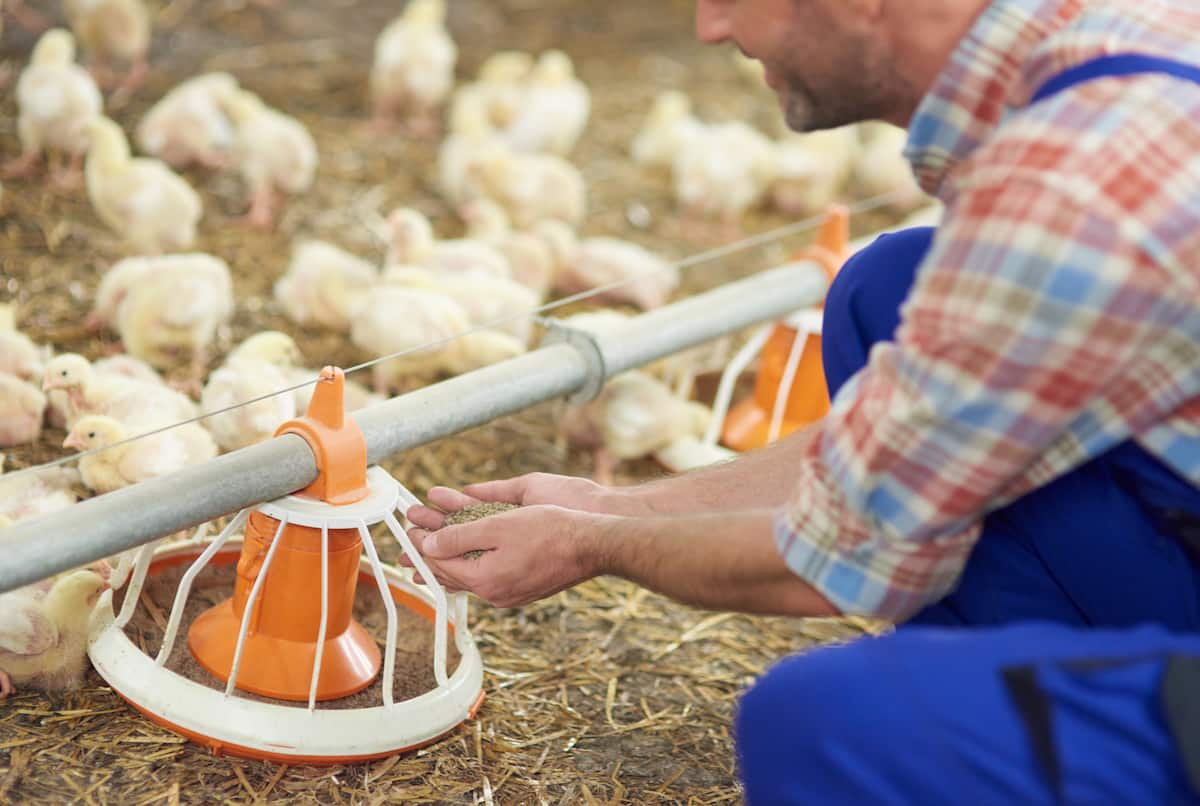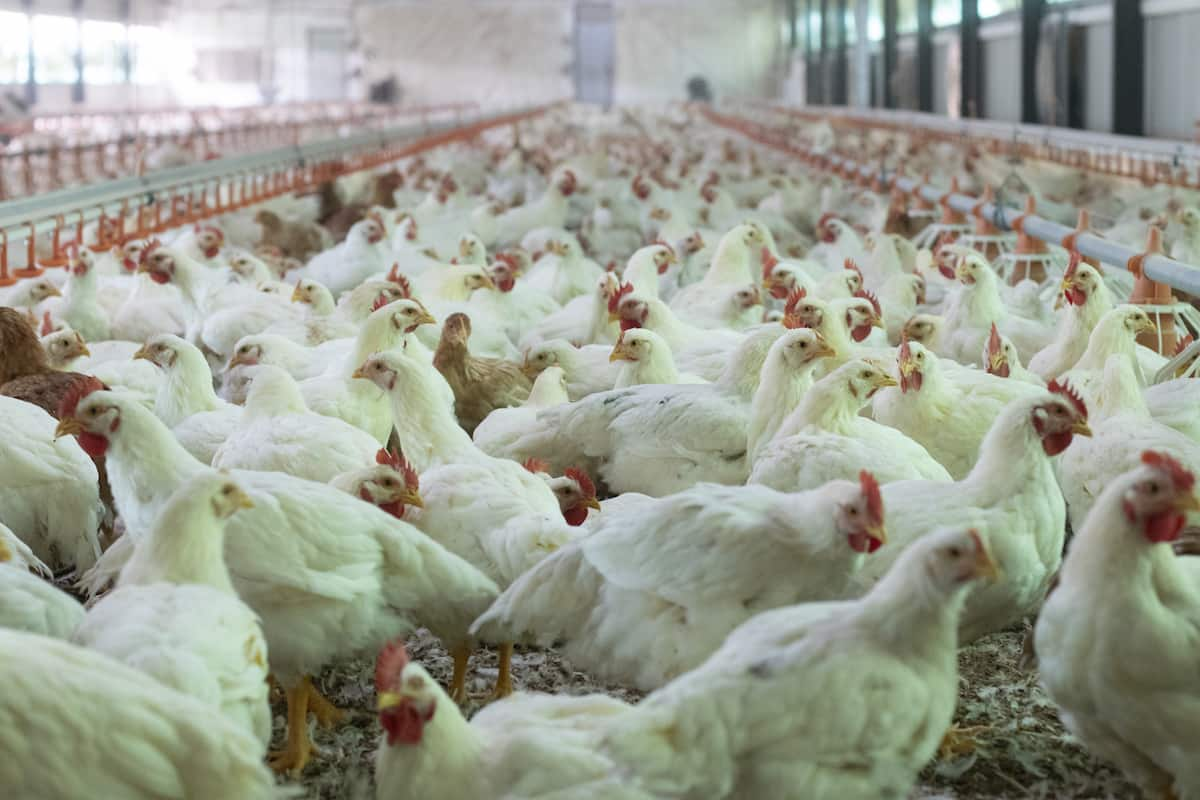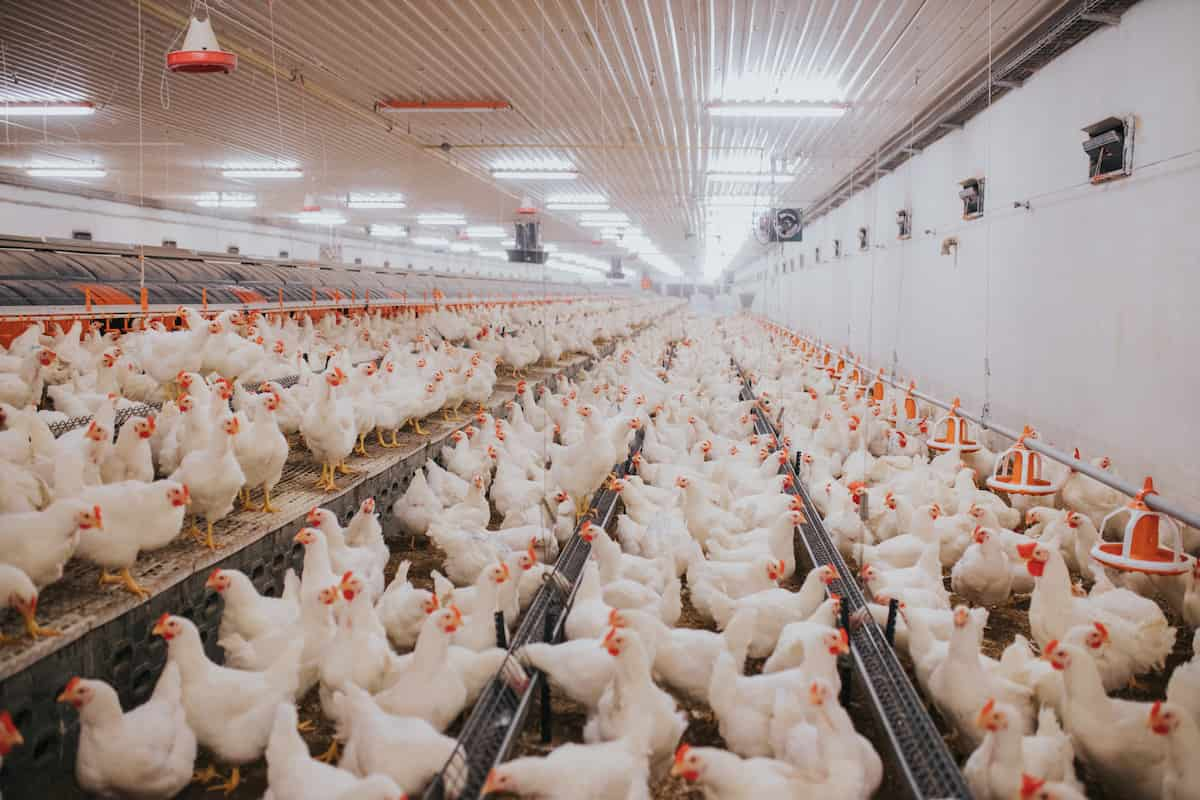Today’s breeds of fast-growing broilers have been selected for their fast growth, feed efficiency, and high feed intake, and broilers are processed when they reach the appropriate market weight, typically by six weeks of age. Feeding management of broiler breeders, including hens and roosters, aims to optimize and profit from reproduction.

In broiler production, feeding represents at least 60% of variable costs, especially in intensive rearing systems. Due to its impact on the growth rate, carcass quality, and its role in certain metabolic diseases, energy intake is an essential factor in broiler production.
Feed Management in Broiler Chickens
Method of Feed Formulation
It is a process by which different feed ingredients are mixed in proportion to provide the nutrition needed at a particular production stage. The nutrient composition of feedstuffs and knowledge of nutrient requirements are essential for feed formulation. It is important that the formulated feed is palatable for the birds and does not cause serious digestive disturbances or toxic effects.
A balanced chicken feed is formulated using information about the nutritional value of ingredients, as well as the maximum inclusion levels, depending on several factors discussed above. Following are approximate inclusion levels of various feed ingredients, which vary depending on different factors, in poultry rations:
For Energy
Up to 65 percent maize, 45 percent jowar (sorghum), 25 percent wheat with enzyme, 15 percent wheat bran, 15 percent rice, and 15 percent rice by-products (bran, polishing).
For Protein
You can use soybean meal up to 30%, sesame oil cake up to 10%, corn gluten up to 15%, linseed meal up to 15% (20% in layers), ground nut oil cake up to 20%, safflower meal or sunflower meal up to 10%, meat meal or fish meal up to 10%, blood meal or feather meal up to 2%.
For Energy and Essential Fatty Acids
Fats and oils like tallow, lard, soybean oil, coconut oil, or palm oil up to 5% after three weeks. Poultry fat, fish, and vegetable oils are good linoleic acid sources and dietary essentials in birds. Besides supplying energy, adding fat improves the absorption of fat-soluble vitamins but increases the inclusion of antioxidants. Birds fed diets having higher levels of polyunsaturated fatty acids tend to produce soft fat.
For Minerals, Vitamins, Essential Amino Acids, and Additives
Calcium can be added as limestone powder (LSP), dicalcium phosphate (DCP), and oyster shells. Phosphorus can be added through manufactured products like dicalcium or monocalcium phosphate. Phytate phosphorus is only available when the phytase enzyme is added to the ration. Sodium and chlorine are usually added in the form of salt (NaCl) at a rate of 0.25%.
Physical Form of Diet for Broilers
The methods provide information about the number of ingredients used in feed formulation. Poultry nutrients are optimally utilized if the formulated feed is given in the appropriate physical form for each bird category. The following physical forms of poultry feed are generally used.
Mash
The term mash refers to ground and completely homogenized feed. All types of birds can consume this feed. It is less expensive to prepare, and less nutrients are lost during processing, but the biggest disadvantage is that mash feed is wasted during handling and consumption.
Pellet
Pellets are formed by compacting ground feed by steaming and forcing it through die openings. All categories of birds over the age of 2 – 3 weeks can use this feed. The preparation cost is higher than that of mash feed. Nevertheless, feed wastage is reduced, and selective feeding is prevented, so nutrients are utilized to the fullest extent possible.
Crumble
Crumble is the term used to describe pelleted feed that has been reduced to granular form. The smaller particle size of this feed makes it more suitable for birds under three weeks of age. Compared to mash feed, preparation costs are higher. Pelletized feed prevents selective feeding and reduces feed wastage.
In case you missed it: How to Start Free Range Chicken Farming in 10 Steps: Business Plan, Management, and Care

Feeding Management of Broiler
Broiler feeding programs emphasize live weight gain, feed conversion ratio, and farmer profitability. For broilers to grow properly, they need a balanced diet of protein and other nutrients. The particle size of the feeds should be appropriate for maximum acceptability during feeding. Crumbled feeds are suitable for babies aged 0-3 weeks, and later mash, or palleted feeds are given. There should be no contamination or fungal infestation in the feed.
Feeding is done with the correct equipment for baby chickens. It is advisable to use a small feeder, and there should be more of them. In proportion to the size of the birds, feeder heights and sizes increase. Two feedings are generally performed daily, in the morning and evening, when feed intake is likely highest due to a cooler environment. Providing the birds with fresh, clean drinking water ensures their optimum performance.
Average Growth Rate and Feed Requirements for Broiler Chicken
| Balanced feed | Age in weeks | Daily feed intake/bird (grams) | Weekly total feed intake (Grams) | Cumulative feed intake (grams) | Body weight gain (g) | Total body weight (g) |
| 0 day | little | 40 | ||||
| pre-starter | 1st week | 25 | 175 | 175 | 188 | 228 |
| pre-starter | 2nd week | 45 | 315 | 490 | 440 | 480 |
| starter | 3rd week | 70 | 490 | 980 | 790 | 830 |
| starter | 4th week | 120 | 840 | 1820 | 1280 | 1320 |
| finisher | 5th week | 145 | 1015 | 2835 | 1795 | 1835 |
| finisher | 6th week | 150 | 1050 | 3885 | 2290 | 2330 |
Effects of Summer Heat on Feed Intake of Poultry Birds
As the environmental temperature increases, the bird’s feed intake decreases. Temperatures between 13 and 20°C are ideal for poultry birds. Feed consumption may decrease by 1.5-2% for every 1°C increase in an ambient temperature between 20°C and 30°C, while feed intake may decrease by 4-5% for every 1°C rise in temperature between 30°C and 40°C. Feed’s energy requirements are reduced in high environmental temperatures, but other dietary nutrients, such as protein, minerals, and vitamins, remain the same.
The levels of these nutrients need to be higher in summer diets. The fall in feed consumption may result in general or specific nutrient deficiencies. The management of heat stress-induced poultry problems can be achieved by implementing temporary feed restrictions or feeding at specific times of the day, increasing the density of nutrients in the diet (because feed intake decreases during heat stress), giving birds extra electrolytes and vitamins (especially through drinking water), or changing the lighting program.
In case you missed it: How to Start Layer Chicken Farming in 10 Steps: Business Plan, Management, and Care

Conclusion
In broiler nutrition, dietary energy is provided by different feed sources. Dietary energy content strongly influences feed consumption, and energy is the most expensive nutrient in poultry diets. Excess energy intake may also increase fat deposition, affecting meat quality and consumer health.
- Feed Your Flock for Less: Top 10 Tips to Save on Chicken Feed
- Ultimate Guide to Ossabaw Island Hog: Breeding, Raising, Diet, and Care
- Hatching Answers: The Top 10 Reasons Your Chickens Aren’t Laying Eggs
- Eggs and Economics: Breaking Down the Cost of Raising Backyard Chickens
- Defend Your Greens: Proven Methods to Keep Iguanas Out of Your Garden
- Ultimate Guide to Cinnamon Queen Chicken: A Comprehensive Guide for Beginners
- Ultimate Guide to California Tan Chicken: Breeding, Raising, Diet, Egg-Production and Care
- Ultimate Guide to Marsh Daisy Chicken: Breeding, Raising, Diet, and Care
- 10 Types of Chicken Farming Businesses You Can Start for Profits